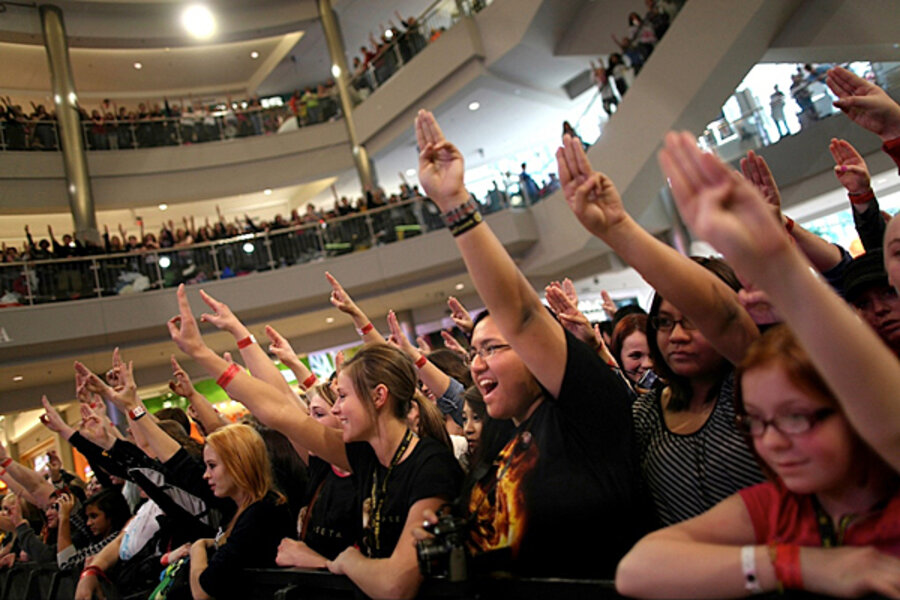The next 'Potter'? 'Hunger Games' takes kids to darker, more violent place.
Loading...
| Los Angeles
The movie version of book one in “The Hunger Games” trilogy is still a week away, but if fan-site buzz and advance ticket sales are any sign, another blockbuster young-adult franchise is being born.
"Harry Potter" begat “Twilight,” which begat “The Hunger Games,” but each begetting has its own quirks.
This series – starring a trio of teens, a format familiar to Harry Potter fans – features a 16-year-old heroine at the helm. It is darker, more dystopian, and less humorous than the tale of the young wizards faced with saving their world from the evil Lord Voldemort.
This time, the foe is a bloodless government that has the people of a fascist, post-apocalyptic future firmly in its grip. The 12 districts of Panem, the entity that has replaced the US in this grittier and quite forsaken devastated land, are annually forced to send child warriors to battle in a televised, lethal, American Idol-style elimination game.
Green skin and cat eyes aside, this is a far less fantastical place – only one survivor can emerge.
The appeal of this tale is very similar to that of the Harry Potter books, but it takes the narrative to a slightly more mature place, says Elisabeth Gruner, associate professor of English at the University of Richmond.
“These are more sophisticated, more violent, and they aim for an older audience,” she says. But, she points out the key similarity in all these recent multi-book narratives, one that is common to much of children’s literature.
“They put children in the middle of the action, positioning them as the saviors of a larger, more confusing adult world,” she says, pointing to everything from the Lewis Carroll Alice tales, where Alice is at the heart of the story, to Lord of the Rings. “They may have been Hobbits,” she notes, “but for the purposes of storytelling, they were perceived as adolescents up against a far more powerful people.”
Many of the fans have embraced Hunger Games with as much commitment as they did Harry Potter. Boston-area high school sophomore Abbie Kaplan says the violence in Hunger Games was an adjustment.
“I had never read anything that detailed before,” she says, “but after I got used to it I really got into it.” The 15-year-old Boston Latin student says she found many parallels between the descriptions in the books and the contemporary world around her, and in some ways found this discouraging.
“It is very corrupt,” she says of the politics described in the book, and adds, “the book obviously exaggerates things but clearly the author has some feelings about the world we live in today.” She ticks off the issues she sees surfacing throughout the narrative, including “manipulation of power and innocent people dying for no reason.”
But, Ms. Kaplan also identifies with the coming-of-age story that lies at the heart of Katniss Everdeen’s struggle to survive and fight back against overwhelming odds. The central character takes the place of her younger sister, who has been designated to fight in the Hunger Games contest.
“She chooses to sacrifice herself for her younger sister,” she says, adding that she has a younger brother the same age. “I don’t know what I would have done,” she says, noting that because they are nearly the same age, she relates to the character’s thoughts and feelings, adding, “she has such amazing courage and strength.”
The story’s violence has been raising concern about the power of the imagery when it migrates from the page to the big screen, points out Us Weekly editor Albert Lee.
But, he notes, “people have been wringing their hands about violence and children ever since Disney killed off Bambi’s mother.”
Mr. Lee says director Gary Ross has gone to great lengths to keep the violence suggestive more than graphic. But, he adds, this grappling with terrifying forces is at the heart of a good children’s story.
“Go back to the scariest fairy tales in the Brothers Grimm and you realize this is what good children’s stories are about,” he says, “the stakes are high, but it shows children they can deal with a scary world.”







